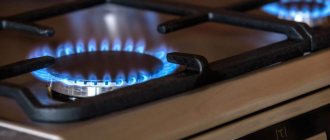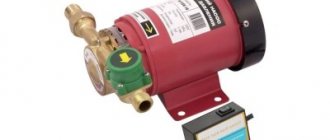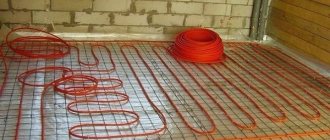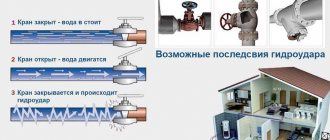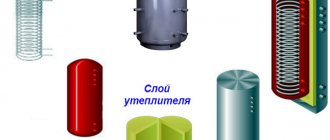How to convert gcal to cubic m
When calculating monthly payments for heating and hot water, confusion often arises. For example, if an apartment building has a communal heat meter, then payments to the heat energy supplier are made for the gigacalories (Gcal) consumed. At the same time, the tariff for hot water for residents is usually set in rubles per cubic meter (m3). To understand payments, it is useful to be able to convert Gcal to cubic meters.
It is necessary to make a reservation that thermal energy, which is measured in gigacalories, and the volume of water, which is measured in cubic meters, are completely different physical quantities. This is known from a high school physics course. Therefore, in fact, we are not talking about converting gigacalories into cubic meters, but about finding a correspondence between the amount of heat spent on heating water and the volume of hot water received.
By definition, a calorie is the amount of heat required to heat one cubic centimeter of water by 1 degree Celsius. A gigacalorie, used to measure thermal energy in thermal power engineering and utilities, is a billion calories. There are 100 centimeters in 1 meter, therefore, in one cubic meter there are 100 x 100 x 100 = 1000000 centimeters. Thus, to heat a cube of water by 1 degree, it will take a million calories or 0.001 Gcal.
The temperature of hot water flowing from the tap must be at least 55°C. If the cold water entering the boiler room has a temperature of 5°C, then it will need to be heated by 50°C. It will take 0.05 Gcal to heat 1 cubic meter. However, when water moves through pipes, heat loss inevitably occurs, and the amount of energy spent on providing hot water supply will actually be about 20% more. The average standard for thermal energy consumption to obtain a cube of hot water is taken to be 0.059 Gcal.
Let's look at a simple example. Suppose that during the inter-heating period, when all the heat is used only to provide hot water supply, the consumption of thermal energy according to the readings of the general building meter was 20 Gcal per month, and the residents in whose apartments water meters were installed consumed 30 cubic meters of hot water.
Why do housing and communal services overestimate the amount of energy spent when paying for heating?
When making your own calculations, it is worth noting that housing and communal services slightly overestimate the standards for thermal energy consumption. The idea that they are trying to earn extra money from this is wrong. After all, the cost of 1 Gcal already includes maintenance, salaries, taxes, and additional profit. This “surcharge” is due to the fact that when hot liquid is transported through a pipeline in the cold season, it tends to cool down, that is, inevitable heat loss occurs.
In numbers it looks like this. According to regulations, the temperature of water in heating pipes must be at least +55 °C. And if we take into account that the minimum temperature of water in power systems is +5 °C, then it must be heated by 50 degrees. It turns out that 0.05 Gcal is used for each cubic meter. However, in order to compensate for heat loss, this coefficient is inflated to 0.059 Gcal.
How to convert m3 of hot water to gcal?
They account for 30 x 0.059 = 1.77 Gcal. Heat consumption for all other residents (let there be 100 of them): 20 – 1.77 = 18.23 Gcal. There are 18.23/100 = 0.18 Gcal per person. Converting Gcal to m3, we obtain hot water consumption 0.18/0.059 = 3.05 cubic meters per person.
When calculating monthly payments for heating and hot water, confusion often arises. For example, if an apartment building has a communal heat meter, then payments to the heat energy supplier are made for the gigacalories (Gcal) consumed. At the same time, the tariff for hot water for residents is usually set in rubles per cubic meter (m3). To understand payments, it is useful to be able to convert Gcal to cubic meters.
It is necessary to make a reservation that thermal energy, which is measured in gigacalories, and the volume of water, which is measured in cubic meters, are completely different physical quantities. This is known from a high school physics course. Therefore, in fact, we are not talking about converting gigacalories into cubic meters, but about finding a correspondence between the amount of heat spent on heating water and the volume of hot water received.
By definition, a calorie is the amount of heat required to heat one cubic centimeter of water by 1 degree Celsius. A gigacalorie, used to measure thermal energy in thermal power engineering and utilities, is a billion calories. There are 100 centimeters in 1 meter, therefore, in one cubic meter there are 100 x 100 x 100 = 1000000 centimeters. Thus, to heat a cube of water by 1 degree, it will take a million calories or 0.001 Gcal.
The temperature of hot water flowing from the tap must be at least 55°C. If the cold water entering the boiler room has a temperature of 5°C, then it will need to be heated by 50°C. It will take 0.05 Gcal to heat 1 cubic meter. However, when water moves through pipes, heat loss inevitably occurs, and the amount of energy spent on providing hot water supply will actually be about 20% more. The average standard for thermal energy consumption to obtain a cube of hot water is taken to be 0.059 Gcal.
Let's look at a simple example. Suppose that during the inter-heating period, when all the heat is used only to provide hot water supply, the consumption of thermal energy according to the readings of the general building meter was 20 Gcal per month, and the residents in whose apartments water meters were installed consumed 30 cubic meters of hot water. They account for 30 x 0.059 = 1.77 Gcal.
Conversion to Gcal
Sometimes it is necessary to carry out the reverse process, that is, to calculate how many Gcal are contained in one kW/hour.
When converting to gigacalories, the number of kilowatt-hours must be multiplied by another “magic” number - 0.00086.
The correctness of this can be verified by taking the data from the previous example.
So, it was calculated that 0.05 Gcal = 58.15 kW/hour. Now it’s worth taking this result and multiplying it by 0.00086: 58.15 x 0.00086 = 0.050009. Despite the slight difference, it almost completely coincides with the original data.
As in previous calculations, it is necessary to take into account the fact that when working with particularly large volumes of substances, it will be necessary to convert not kilowatts, but megawatts into gigacalories.
How is this done? In this case, again you need to take into account that 1 mW = 1000 kW. Based on this, the decimal point in the “magic” number is moved by three zeros, and voila, it turns out to be 0.86. It is by this that you need to multiply to make the translation.
By the way, a small discrepancy in the answers is due to the fact that the coefficient 0.86 is a rounded version of the number 0.859845. Of course, for more accurate calculations it is worth using it. However, if we are talking only about the amount of energy used to heat an apartment or house, it is better to simplify.
Having received a receipt for paying for a utility bill, many Russians look at it with bewilderment, trying to understand what is encrypted in the mysterious abbreviations, and for what services they need to shell out quite a lot of money.
Unfortunately, until now utility companies have not bothered to bring the receipts issued in different regions of Russia to a single standard. The content of these payment documents lies entirely within the imagination and administrative delight of local authorities.
Do housing and communal services have the right to come up with names for their services?
The list of services that must be paid for by residents of apartment buildings is clearly defined by Article 154 of the main industry document - the Housing Code. Homeowners and tenants are required to pay for housing maintenance and repairs. In addition, their responsibility includes payment for services:
— cold water supply (CWS), i.e. supplying cold water through the water supply to the tenant’s apartment;
— hot water supply (DHW), which consists of payment for water supply and heating;
- water disposal, i.e. ensuring the operation of the sewer collector that removes wastewater;
— gas supply;
It is unacceptable to change the names of these services, although some regional housing and communal services arbitrarily enter into their payment receipts such lines as “DHW heating”, “DHW replenishment” or “DHW and hot water drainage”. It is not at all necessary for the consumer to know how much it costs to heat water; what is important to him is the final amount that is presented for payment.
Of course, in the case when a resident of a house wants to know about each utility service, the housing and communal services are obliged to provide him with all the information about what costs make up a particular utility tariff.
What abbreviations can be found on receipts?
Since utility services are in no hurry to bring payments to a single standard, it will not hurt payers to navigate the abbreviations that can encrypt certain components of utility payments.
— HVS DPU
– this is cold water supply (payment for cold water supply) according to the house meter, i.e.
in accordance with the readings of the common house meter (if your house has one). If the meter is installed in your apartment, the receipt may indicate the HVS KPU
(apartment metering device).
— DHW DPU
- accordingly, hot water supply, calculated according to the house meter.
— Drainage
– sewerage services, which are called sewerage in bills.
— Cold water for domestic hot water
- this is how the intricate concept of cold water supply for hot water supply is denoted. According to the plans of the utility workers, you must separately pay for the supply of cold water for heating, and in another line - the cost of heating this cold water. The cost of DHW is the sum of these lines
— Heating basic pl.
– this is how heating the main area of your apartment is usually designated, i.e. the minimum that is due to residents registered in the apartment.
— Heating izl. pl.
– this is the cost of heating the excess space of your apartment. It usually costs more than heating the minimum square meters you are entitled to.
— Opl. lived
- This is payment for housing.
— Contents and rem.
– means paying for the maintenance and repairs of your apartment. This includes maintenance of utility networks inside your home, their ongoing repairs, repairs of technical devices and structures of a residential building, as well as many other costs.
— Lived izl. pl.
– payment for housing based on excess space.
Now it will be easier for you to understand the contents of your utility bill. A separate topic is the formation of tariffs for which payments are calculated.
The most impressive frauds related to unjustified charging of payments are committed here. As a rule, only a specialist with experience in utility networks can assess how justified each figure in the utility tariff is.
Payment for hot water is one of the main expense items for apartment owners in apartment buildings. Management companies regularly receive questions regarding both the charging of fees for this service and the current tariffs. In the article we will deal with all these points and provide useful reference material, including a table with hot water tariffs updated in 2021 in Moscow.
Many consumers are still surprised by the appearance of the “water heating” item in the payment for housing and communal services. This innovation appeared quite a long time ago - in 2013. According to Government Decree No. 406 of May 13, 2013, in houses with a centralized water supply system, payment must be made according to a 2-component tariff.
The traditional hot water tariff was divided into two parts:
- cold water consumption;
- heat consumption.
For this reason, a line appeared on the receipt indicating the amount of heat spent on heating cold water. Many people think that payment for this heating is being charged illegally, although it is indeed legal. The head of expert support for the MKD Management help system answered the question of how to calculate the fee for hot water supply for different categories of houses? .
The innovation was required due to the fact that residents additionally use an unaccounted amount of energy. Heated towel rails and risers are connected to the hot water system, which consume heat. These costs were not previously taken into account when calculating payments for CG. Taking money for heat supply is allowed only during the heating season, so heating the air through the operation of a heated towel rail as a utility service was not subject to payment. The solution was found precisely in the form of such a division of the tariff into two parts.
For a better understanding, it is worth describing the situation with DHW heating in numbers. If nothing else is required from cold water other than cleanliness and pressure, then with hot water everything is a little more complicated. In the case of DHW, another parameter is added - temperature. The supplier must withstand it, otherwise complaints are received, an inspection is ordered, and if violations are confirmed, the payment is reduced. For hot water, the temperature must be at least +60ºС.
The analysis revealed that heating hot water circulating through pipelines consumes about 40% of the heat generally required for domestic hot water supply at home. The hot water coming from the supplier is not consumed in full and is sent through the return pipe to the heat exchanger, where it is heated by boiling water supplied to the house. It cools down as it passes through the pipes. If little water is consumed in an apartment building, then heat losses can reach significant values, and the fee paid by the owners at a one-component tariff will not be enough to cover all costs.
Dividing the tariff so that the cost of heating water is taken into account separately was a solution to this problem.
How many cubic meters are in a gigacalorie? Let's learn how to calculate heating costs taking into account odpu
How to convert gigacalories to cubic meters
When receiving utility bills, it is quite difficult to understand many aspects of the calculations and understand: where did this or that figure come from? One of the most striking examples of such “translation difficulties” is payment for supplied heat. If your home has a single heat meter installed, then you will receive bills for the Gcal (gigacalories) used, but the tariff for hot water, as you know, is set for cubic meters. How to figure out how to calculate the cost of heat?
Perhaps the greatest difficulty lies precisely in the technical impossibility of converting gigacalories into cubic meters or vice versa. These are completely different physical quantities: one serves to measure thermal energy, the other – volume, and, as a basic physics course suggests, they are incomparable. The task of the utility consumer ultimately comes down to calculating the ratio of the amount of heat expended and the volume of hot water consumed.
In order not to get completely confused, it is worth starting with determining the calculated values. So, by calorie we mean the amount of heat that is necessary to heat one cubic centimeter of water by 1°C. There are a billion calories in a Gcal, and a million centimeters in a cubic meter, therefore, to heat one cubic meter of water by 1°C you will need 0.001 Gcal.
Considering that hot water should not be colder than 55°C, and cold water arrives at a temperature of 5°C,
Obviously, you will need to heat it by 50°C, that is, spend 0.05 Gcal of thermal energy on each cubic meter. In the sphere of housing and communal services tariffs, there is a slightly higher heat consumption standard for heating one cubic meter of water - 0.059 Gcal, this is due to heat losses that occur when transporting water through a pipeline.
Then everything is simple, divide the heat consumption according to the readings of the house meter by the number of residents. In this way, obtain the heat consumption for each resident, and dividing the resulting figure by the standard 0.059 is the volume of hot water in cubic meters that must be paid for by each resident. The only subtlety in this calculation is the need to subtract from it those residents who have consumption meters installed in their apartment.
Let's look at the calculation using an example: the consumption according to a common house meter was 30 Gcal, residents who have internal metering devices used a total of 35 m³ of hot water, residents without metering devices in the house - 75 people.
35*0.059 = 2.065 – this is the amount of heat consumed by residents who have metering devices;
30-2.065 = 27.935 Gcal – the balance of consumption for the remaining residents;
27.935/75 = 0.372 Gcal – heat consumption per resident;
0.372/0.059 = 6.31 m³ of hot water will be billed to each tenant whose apartments are not equipped with metering devices.
Calculation of a hot water supply system: important parameters
When you open a tap, you sometimes have to wait a while for hot water to come out.
This happens because cold water must first come out of the supply pipe, since this is what the pipeline is filled with while there is no water intake. The problem of “user expectations” is not the only one in design - this and other problems can be solved by specialists who calculate the hot water supply system. So, it happens that you need to drain the water for some time, and this is an excessive waste of resources. The circulating water supply (hot water circulates in it) almost instantly provides the required temperature. But there are some facts pros and cons of its device:
- pros - well suited for facilities with a large number of users, for example, for apartment buildings, which justifies the high cost of such a network;
- disadvantages - heat loss due to the constant circulation of hot water in the network, which increases the energy bill.
Designers are required to study the principle diagram of water supply, which includes plumbing fixtures (this diagram is also used when calculating cold water supply is needed). The task arises - to optimally reduce the length of the supply pipeline and understand how appropriate it is to use a circulation system given the acceptable waiting time for hot water. It is believed that the acceptable waiting period for residential properties is about a minute.
Example of a home water supply project
Back
Forward
Useful
Thermal Energy Units
Calorie (Cal) is a unit of thermal energy;
Watt (W) - a unit of thermal or electrical energy;
Joule (J) is the SI unit of work and energy;
1 kcal/hour = 1.163 W;
1 Gcal/hour = 1.163 mW;
1Kcal = 1000 cal; 1 Mcal = 1000 Kcal = 1000,000 cal; 1 Gcal = 1000 Mcal = 1000,000,000 cal
Coolant flow by heat load
G (m3/hour) = Q Gcal/hour * 1000 / (Tpod. - Tb.)°C,
where: Q Gcal/hour - available thermal energy;
Tpod. — coolant temperature in the supply pipeline;
Other methods for calculating Gcal for heating
You can calculate the amount of heat that enters the heating system in other ways. For example, the formula for calculating Gcal can have two other forms:
- Q = ((V1 * (T1 - T2)) + (V1 - V2) * (T2 - T)) / 1000.
- Q = ((V2 * (T1 - T2)) + (V1 - V2) * (T1 - T)) / 1000.
All values in these formulas are the same as in the previous formula. Based on the above calculations, we can conclude that you can calculate Gcal for heating yourself. But you should seek advice from special companies that are responsible for supplying heat to the house, since their work and calculation system may differ from these formulas and consist of a different set of measures.
If you decide to make a “Warm Floor” system in your private home, then the principle of heating calculation will be completely different. The calculation will be much more complicated, since it is necessary to take into account not only the features of the heating circuit, but also the values of the electrical network from which the floor is heated. The companies that are responsible for monitoring the installation of heated floors will be different.
Many residents have difficulty converting kilocalories to kilowatts. This is due to many manuals of measuring units in the international system, which is called “C”. When converting kilocalories to kilowatts, the coefficient 850 should be used. That is, 1 kW equals 850 kcal. This calculation is much simpler than others, since it is not difficult to find out the required volume of gigacalories. 1 gigacalorie = 1 million calories.
During the calculation, it should be remembered that any modern devices have a small error. Mostly they are acceptable. But you need to calculate the error yourself. For example, this can be done using the following formula: R = (V1 - V2) / (V1+V2) * 100, where:
- R – error of a common house heating device.
- V1 and V2 are the previously indicated water flow parameters in the system.
- 100 is the coefficient that is responsible for converting the resulting value into a percentage. In accordance with operational standards, the maximum error that can be is 2%. Basically, this figure does not exceed 1%.
How many cubes of saturated steam are in one gigacalorie? How to convert gigacalories to cubic meters
— temperature of the coolant in the return pipeline.
Determine the speed of water in the pipe
The speed of water movement is determined by the formula: V (m/s) = 4Q/π D2 ,
where: Q - water flow in m3/sec; π = 3.14;
D is the diameter of the pipeline in m2;
Calculation example: Water flow Q = 5 m3/hour = 5 m3/3600 s = 0.001388 m3/s; Pipe diameter = 50 mm = 0.05 m;
V = 4 *0.001388 / 3.14 * 0.005*0.005 = 0.707 m/s
When calculating systems, the diameter (nominal diameter) of the pipeline is determined from the condition
that the average speed of the coolant in shut-off devices, in order to avoid water hammer when closing, should not exceed 2 m/s.
The speed of movement of the coolant in the pipes of water heating systems should be taken depending on the permissible sound level:
— no more than 1.5 m/s in public buildings and premises;
— no more than 2 m/s in administrative buildings and premises;
— no more than 3 m/s in industrial buildings and premises.
(minimum speed of water movement from the condition of air removal V = 0.2-0.3 m/s)
Consumption
It can be approximately estimated by consumption rates for individual plumbing fixtures. If desired, it is easy to find the data in one of the annexes to SNiP 2.04.01-85; For the convenience of the reader, we present an excerpt from it.
| Device type | Cold water consumption, l/s | Total consumption of hot and cold water, l/s |
| Irrigation tap | 0,3 | 0,3 |
| Toilet with tap | 1,4 | 1,4 |
| Toilet with cistern | 0,10 | 0,10 |
| Shower stall | 0,08 | 0,12 |
| Bath | 0,17 | 0,25 |
| Washing | 0,08 | 0,12 |
| Wash basin | 0,08 | 0,12 |
In apartment buildings, when calculating consumption, the probability coefficient of simultaneous use of devices is used. It is enough for us to simply sum up the water consumption through devices that can be used simultaneously. Let's say a sink, shower and toilet will give a total flow rate of 0.12 + 0.12 + 0.10 = 0.34 l/s.
Water consumption through devices that can operate simultaneously is summed up.
Control valve calculation
Kv (Kvs) of the valve is a characteristic of the valve’s capacity; it is the conditional volumetric flow of water through a fully open valve, m3/hour at a pressure difference of 1 Bar under normal conditions. The indicated value is the main characteristic of the valve.
, where G is fluid flow, m3/hour;
Δp - pressure drop across a fully open valve, bar
When selecting a valve, the Kv , then rounded up to the nearest value corresponding to the rating characteristic (Kv) of the valve . Control valves are usually produced with Kvs values that increase exponentially:
Kvs: 1.0, 1.6, 2.5, 4.0, 6.3, 10, 16 …………
Calculate radiator
Accurate thermal calculations are made using special methods.
An approximate calculation of the required thermal power for central Russia can be calculated using the following formula:
Power kW.= (Ld * Lsh * Hv) / 27,
where: Ld - length of the room, m; Lsh—room width, m; Hв - ceiling height, m.
When paying thousands of dollars for scorching and hot water, plutanium is often to blame. For example, if in a large apartment building there is a heat exchanger, then the supply of thermal energy is carried out for the same gigacalories (Gcal). Currently, the tariff for hot water for local residents is usually set in rubles per cubic meter (m3). To arrange payments, please remember to convert Gcal to cubic meters.
It is necessary to remember that thermal energy, which is measured in Gcal, and water consumption, which is expressed in cubic meters, are completely different physical quantities. This is known from the middle school physics course. Therefore, we are really not talking about converting gigacalories into cubic meters, but about finding the difference between the amount of heat spent on heating the water and the hot water that has been removed.
By definition, a calorie is the amount of heat required to heat one cubic centimeter of water by 1 degree Celsius. A gigacalorie is stored for the world of thermal energy in the heat energy and municipal government, which is a billion calories. There are 100 centimeters in 1 meter, so in one cubic meter there are 100 x 100 x 100 = 1,000,000 centimeters. Thus, to heat a cube of water by 1 degree, you will need a million calories or 0.001 Gcal.
The temperature of the hot water flowing from the tap must become no less than 55°C. If the cold water entering the boiler room has a temperature of 5°C, then it will need to be heated by 50°C. To heat up 1 cubic meter, 0.05 Gcal will be required. However, with Russian water flowing through pipes, there will inevitably be heat losses, and the amount of energy spent on the provision of hot water pumps will be approximately 20% higher in operation. The average standard of accumulated thermal energy for extracting a cube of hot water is taken to be 0.059 Gcal.
Let's take a look at a simple butt. Please, during the mid-season period, when all the heat goes only to the provision of the GVP, the consumption of thermal energy according to the readings of the zagalnobudinkovo doctor amounted to 20 Gcal per month, and the residents, in apartments in which water tanks were installed, spent 30 cubic meters hot water. They contain 30 x 0.059 = 1.77 Gcal. Heat loss for all other units (at least 100): 20 - 1.77 = 18.23 Gcal.
Engineer's world
The methodology is intended for the correct selection of heat and water meters for consumers of closed heat supply systems in Moscow. The maximum and minimum coolant and water flow rates determined using the above method must be within the water flow measurement range of the selected heat or water meter with the relative error regulated by the Rules for the metering of thermal energy and coolant.
The methodology was developed on the basis of current regulatory documents:
- SNiP 2.04.07-86* “Heat networks”, M. 1994
- SNiP 2.04.01-85 “Internal water supply and sewerage of buildings”, M. 1986.
- SP41-101-95 “Design of heating points”, M. 1997.
- Maximum hourly water flow from the heating network of a closed heating supply system with a two-stage connection scheme for hot water supply water heaters according to paragraphs. 5.2 and 5.3 SNiP 2.04.07-86* (formulas 9, 10, 16, 18 in the unit system adopted for heat calculations - Gcal/h), in general form it is found from the following expression (in t/h):
GС.MAX = GO.MAX + GВ.MAX + GDHW MAX = QО.MAX / [(t1 – t2)*c] + QВ.MAX / [(t1 – t2)*c] + 0.55 QDHW.MAX / [(t1| — t2|)*c] (1)
QО.MAX, QВ.MAX, QГВС.MAX – maximum hourly heat consumption for heating, ventilation and hot water supply, in Gcal/h;
t1 and t1| – water temperature in the supply pipeline of the heating network at the design temperature of the outside air and at the break point of the temperature graph, respectively, for the conditions of Moscow t1 = 1500 C, t1| = 700 C for HPP-1, CHPP-8, 9, 11, 12 and t1| = 800 C – for other CHPPs and RTS;
t2 and t2| – water temperature in the return pipeline of the heating network at the design temperature of the outside air and at the break point of the temperature graph, respectively, the day conditions of Moscow, depending on the heating connection diagram:
- with dependent connection t2=700 C; t2| =420С;
- with independent connection t2 =800 C; t2| = 450C;
C is the heat capacity of water, it is allowed to take 10-3 Gcal/(t.deg).
Substituting the indicated values instead of the letter values, we obtain the maximum water consumption, in t/h, at t1| = 800С:
- for a system with dependent heating connection:
GC.MAX = 12.5 QO.MAX + 12.5 QV.MAX + 14.5 QDHW.MAX (2)
- for a system with independent heating connection and heat supply for ventilation through separate pipelines:
GC.MAX = 14.3 QO.MAX + 12.5 QV.MAX + 15.7 QDHW.MAX (3)
- the same goes for supplying heat to ventilation through the same pipelines as for heating:
GC.MAX = 14.3 (QO.MAX + QB.MAX) + 15.7 QDHW.MAX (4)
(15.7 - replaced by 18.2 - for all cases, postscript for formula (4))
Notes:
a) for heating points located in the coverage area of HPP-1, CHPP - 8, 9, 11, 12 (t1| = 700C), the last term of formula 2 should be written as (19.6 * Q DHW.MAX ), and in formulas 3 and 4, as (22 * Q DHW.MAX );
b) the maximum hourly water flow from the heating network of a closed heating system during the non-heating period should be taken in accordance with paragraphs. 5.2 and 5.4, the same SNiP 2.04.07-89* (formulas 14 and 19):
GC.MAX.YEARS =$*QDHW.MAX / [(t1L – t|3)] = 20-25* QDHW.MAX (5)
$ – coefficient taking into account the change in water consumption during the non-heating period in relation to the heating period, adopted in accordance with Appendix 1 of the same SNiP for the housing and communal services sector, equal to 0.8; for enterprises – 1.0.
t1Л – water temperature in the supply pipeline of the heating network during the non-heating period; for Moscow, from the conditions of connection to the heating network – 700C.
t|3 – water temperature in the return pipeline, taken equal after a parallel-connected water heater according to Appendix 1 t|3 = 300C.
- The minimum hourly water flow from the heating network of a closed heating system is determined during the non-heating period based on the load on the hot water supply:
- in the absence of circulation in the hot water supply system, or when it is turned off in buildings with periodic operation, taking into account the average water consumption for hot water supply during the non-heating period according to formulas 13 and 19 SNiP 2.04.07-86*:
GC.MIN = $*QDHW.SR. / [(t1L – t|3 )*c] = 20-25*QDHW.SR. (6)
- if there is circulation in the hot water supply system - taking into account the provision of water heating in circulation mode at night:
GC.MIN = QCIRC,DHW / [(t1L – t26)*c] (7)
t26 – water temperature in the return pipeline of the heating network after the hot water supply water heater operating in the circulation flow heating mode, taken to be 50 C higher than the minimum permissible temperature of hot water at the water intake points (also in the circulation pipeline at the heated water inlet before the water heater) in accordance with SNiP 2.04.01-85, clause 2.2 t26 = 50 + 5 =550 C;
QCIRC,DHW – heat consumption for heating circulating water, equal to heat loss by hot water supply pipelines, which, in the absence of data, are determined according to SP 41-101-95, clause 4, Appendix 2:
QCIRC.DHW = KTP.*QOGVS.SR. / (1+CTP.) (8)
KTP. – coefficient taking into account heat loss by pipelines of the hot water supply system, taken depending on the type of system according to the following table:
| Coefficient taking into account heat loss by pipelines, package transformer substations. | ||
| Types of hot water systems | In the presence of hot water supply heating networks after the central heating point | Without heating hot water supply networks |
| With insulated risers, without heated towel rails | 0,15 | 0,1 |
| Also with heated towel rails | 0,25 | 0,2 |
| With non-insulated risers and heated towel rails | 0,35 | 0,3 |
Notes:
- The first line, as a rule, refers to the system of public and industrial buildings, the second - to residential buildings constructed according to projects after 1976, the third - to residential buildings constructed according to projects before 1977.
- Since heat losses from hot water supply pipelines are almost the same throughout the year and are specified as a fraction of the average hourly heat consumption, in the summer they should not decrease by the water consumption reduction factor.
- If there are independent pipelines through which water for the hot water supply system enters the heating point, the maximum hourly water flow through the supply pipeline is determined, as in open heat supply systems, according to formula 12 clause 5.2, SNi112.04.07-86*.
GDHW.MAX = QDHW.MAX / [(tG – tX)*s] = 18.2 QDHW.MAX (9)
tG – water temperature in the supply pipeline of the hot water supply system, taken equal to 600 C;
tХ – water temperature in the water supply, tХ = 50 C.
The minimum water flow in the supply pipeline is assumed to be equal to the circulation water flow, which is determined according to SNiP 2.04.01-85, clause 8.2:
GDHW.MIN. = GCIRCUS. = &C.*QCIRCUS. / (?t*c) (10)
&C. – circulation misregulation coefficient;
?t is the difference in water temperature in the supply pipeline of the DHW system at the outlet of the water heater to the most remote water distribution point, taking into account heat losses through the circulation pipelines.
For systems in which water circulation is provided through water risers and with the same resistance of sectional units or risers, &C. = 1.3; ?t = 100С.
The maximum water flow rate in the circulation pipeline of the hot water supply system, taking into account the possible increase in circulation in practice due to the margin in the selection of circulation pumps, should be taken as 1.5 times greater than the design circulation pump:
GCIR.MAX = 1.5*GCIR. (eleven)
The minimum water consumption in the circulation pipeline of the hot water supply system should be taken based on its possible reduction at maximum water withdrawal to 40% of the calculated value.
GCIR.MIN = 0.4*GCIR. (12)
- In the case when, in the summer, a heat or water meter located at the entrance of the heating network pipelines to a heating point does not fit within the calculated limits for water consumption, in order to be able to measure heat consumption for hot water supply, it is necessary to either re-calibrate the installed heat or water meter (if the design of the device allows this), or in the summer, replace the heat or water meter with the same device of a smaller diameter, the measuring range of water flow of which corresponds to the flow rates determined according to formulas 5 and 6 of this methodology.
It is allowed, if the contract load for hot water supply is less than 0.5 Gcal/h, the amount of heat consumed in the summer is determined by a water meter installed on the cold water pipeline entering the hot water supply water heater, taking into account heat losses in the pipelines according to the table above.
The maximum water consumption is determined based on the maximum hourly heat consumption for hot water supply:
GHW.MAX = QDHW.MAX / [(tG – tX)*c] = 18.2 QDHW.MAX (13)
The minimum water consumption should be determined based on the average hourly water consumption for hot water supply in the summer:
GHW.MIN = $*QDHW.SR / [(tG – tX)*c] = 14.6-18.2 QDHW.SR (14)
Where the value 14.6 is taken at $=0.8, and 18.2 – at $=1.
Share link:
Gigacalorie
As units of the amount of heat in technology, the joule (J), international calorie (cal) and multiple units are accepted: kilocalorie (kcal), megacalorie (Mcal), gigacalorie (Gcal): 1 cal 4 1868 J (exactly) 4 19 J; 1 kcal 1000 cal 4 19 kJ; 1 Mcal 1000 kcal 1,000,000 cal 4 19 MJ; 1 Gcal 1000 Mcal 1,000,000 kcal 1,000,000,000 cal 4 19 GJ.
The most important indicator characterizing a boiler room in the heat supply system to consumers is its thermal power (performance) - the total maximum power for all types of coolants supplied by the boiler room to consumers, expressed in gigacalories per hour.
Specific strength, unit - kilogram-force-centimeter per gram square meter per kilogram-force square centimeter per kilogram-force kilogram-force-second per square meter kilogram per second-meter kilogram-force per meter kilogram-force-meter per square centimeter kilogram-force centimeter per square centimeter Darcy kilogram per hour per meter-millimeter of water kilogram per hour per meter-0 1 atmosphere gram per hour per meter-millimeter of mercury cubic meter per hour per meter - millimeter of water teracalorie gigacalorie megacalorie kilocalorie calorie calorie thermochemical calorie per gram kilocalorie per kilogram calorie per gram degree Celsius kilocalorie per kilogram degree Celsius calorie per gram kelvin kilocalorie per kilogram kelvin kilogram-force meter per kilogram degree Celsius calorie per second kilocalorie per hour megacalorie per hour kilocalorie per hour per square meter megacalorie per hour per square meter kilocalorie per hour per cubic meter megacalorie per hour per cubic meter kilocalorie per hour per square meter-degree Celsius calorie per second per square centimeter-degree Celsius kilocalorie per hour per meter-degree Celsius calorie per second per centimeter degree Celsius ohm-square millimeter per meter curie curie per kilogram curie per gram curie per cubic meter curie per liter curie per milliliter curie per square meter curie per square centimeter rad kgf cm/g M2/KGS CM2/KGS kgf s / m2 kg / ( s-m) kgf / m kgf m / cm2 kgf cm / cm2 d KG / ( H - M - MM WOD.
In cases where great precision is not required, values are given in rounded figures. The same applies to the gigacalorie, since peak water boilers are labeled in this unit in terms of heating output.
The amount of heat is expressed in gigajoules or gigacalories. The latter unit continues to be widely used due to the ease of transition to this unit from the unit of mass and temperature.
Thus, the cost of heat transport consists of a number of cost items associated with the operation of heat pipelines and pumping substations; it fluctuates depending on local conditions. For example, in the Moscow Heating Network the cost of transporting one gigacalorie is 18 kopecks.
Pressure
Let's start with a few general notes:
- Typical pressure in the cold water supply line is from 2 to 4 atmospheres (kgf/cm2) . It depends on the distance to the nearest pumping station or water tower, the terrain, the condition of the main, the type of shut-off valves on the main water supply and a number of other factors.
- The absolute minimum pressure that allows all modern plumbing fixtures and water-using household appliances to operate is 3 meters . The instructions for Atmor instantaneous water heaters, for example, directly state that the lower response threshold of the pressure sensor that turns on heating is 0.3 kgf/cm2.
The pressure sensor of the device is triggered at a pressure of 3 meters.
Reference: at atmospheric pressure, 10 meters of pressure corresponds to 1 kgf/cm2 of excess pressure.
In practice, it is better to have a minimum pressure of five meters at the end plumbing fixture. A small reserve compensates for unaccounted losses in connections, shut-off valves and the device itself.
We need to calculate the pressure drop in a pipeline of known length and diameter. If the difference in pressure corresponding to the pressure in the main line and the pressure drop in the water supply system is more than 5 meters, our water supply system will function flawlessly. If it is less, you need to either increase the diameter of the pipe or open it by pumping (the price of which, by the way, will clearly exceed the increase in costs for pipes due to an increase in their diameter by one step).
So how is the pressure in the water supply network calculated?
The formula H = iL(1+K) applies here, in which:
- H is the treasured pressure drop value.
- i is the so-called hydraulic slope of the pipeline.
- L – pipe length.
- K is a coefficient that is determined by the functionality of the water supply system.
The easiest way is to determine the K coefficient.
It is equal to:
- 0.3 for household and drinking purposes.
- 0.2 for industrial or fire-service.
- 0.15 for fire and production.
- 0.10 for a firefighter.
The photo shows a fire water supply.
Measuring the length of a pipeline or its section also does not pose any particular difficulties; but the concept of hydraulic slope requires a separate discussion.
Its value is influenced by the following factors:
- The roughness of the pipe walls, which, in turn, depends on their material and age. Plastics have a smoother surface compared to steel or cast iron; In addition, steel pipes become overgrown with lime deposits and rust over time.
- Pipe diameter. There is an inverse relationship here: the smaller it is, the greater the resistance the pipeline has to the movement of water in it.
- Flow rate. As it increases, the resistance also increases.
Some time ago, it was necessary to additionally take into account hydraulic losses on shut-off valves; however, modern full bore ball valves create about the same resistance as a pipe and can therefore be safely ignored.
An open ball valve offers almost no resistance to the flow of water.
Calculating the hydraulic slope on your own is very problematic, but, fortunately, this is not necessary: all the necessary values can be found in the so-called Shevelev tables.
To give the reader an idea of what we are talking about, we present a small fragment of one of the tables for a plastic pipe with a diameter of 20 mm.
| Consumption, l/s | Flow speed, m/s | 1000i |
| 0,25 | 1,24 | 160,5 |
| 0,30 | 1,49 | 221,8 |
| 0,35 | 1,74 | 291,6 |
| 0,40 | 1,99 | 369,5 |
What is 1000i in the far right column of the table? This is just the value of the hydraulic slope per 1000 linear meters. To get the value of i for our formula, it is enough to divide it by 1000.
Let's calculate the pressure drop in a pipe with a diameter of 20 mm with a length of 25 meters and a flow speed of one and a half meters per second.
- We look for the corresponding parameters in the table. According to her data, 1000i for the described conditions is equal to 221.8; i = 221.8/1000 = 0.2218.
Shevelev's tables have been republished many times since their first publication.
- Substitute all values into the formula. H = 0.2218*25*(1+0.3) = 7.2085 meters. With a pressure at the inlet of the water supply system of 2.5 atmospheres, at the outlet it will be 2.5 - (7.2/10) = 1.78 kgf/cm2, which is more than satisfactory.
